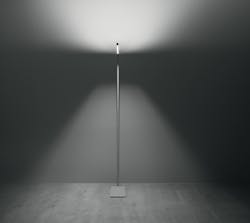Zumtobel conceives new form for floor-standing LED office luminaire
The Linetik SSL product integrates LEDs and reflector-based optics in a sleek design with a tiny cross-section, and the luminaire can deliver both direct and indirect light.
Zumtobel has announced the Linetik floor-standing LED-based luminaire designed for use in office applications. The luminaire design features a 24×24-mm cross-section yet still manages to integrate a reflector-based optical design that eliminates glare and yields a uniform direct beam pattern. Zumtobel placed visual comfort as the main goal in the solid-state lighting (SSL) product development and engaged some leading lighting designers to collaborate on the sleek and elegant luminaire.
While the Linetik luminaire design relies on inherently-efficient LED sources, a more profound concept of efficiency pervaded the project. The team behind the luminaire sought to control the beam so that light is directed only where needed with no energy being used to essentially create unutilized photons. Moreover, the team took a minimalist approach in terms of materials required in construction.
"The requirements for Linetik were clear," said Sebastian Schubnell, Zumtobel project manager for future lighting solutions. "Ensure the best lighting technology in the smallest space, delivering light that can be individually controlled by the user."
In the development process, Zumtobel turned to Simon Fisher and Matt Free from lighting-design firm F Mark Ltd, and Luke Smith-Wightman, who runs his own design firm. "We have questioned absolutely everything – from existing lighting solutions to the way offices are designed," said Matt Free. The unique shape of Linetik grew out of a desire to really only use what is needed."
The luminaire design is capable of delivering both direct light downward for task needs and indirect light upward for ambient needs. As you can see in the nearby photos, the design is linear in nature with light-emitting surfaces on the top and bottom of the luminaire. The design uses vastly different optical systems for the two lighting needs.
The reflector-based system that controls the direct light required the use of unique materials and manufacturing techniques. A composite material forms the series of reflector elements along the length of the design with a vapor-delivered aluminum coating delivering high reflectivity. On the indirect side, the team used a simpler extrusion lens to spread ambient light over a wide area of the ceiling.
Integrated control technology gives office workers separate control over the direct and indirect light. Moreover, a motion sensor can enable autonomous on-off control.
The luminaire delivers 6000 lm along the 1240-mm length of the products in a choice of 3000K or 4000K CCTs with CRI greater than 80. The 56W product delivers efficacy of 107 lm/W.
Zumtobel has announced a number of LED-based products in the past year that tap science to deliver light that is pleasing to workers. For example, the company relied on Fraunhofer research in developing tunable office luminaires. The new design, however, truly pushes innovation in form.
We are seeing more products come to market that truly leverage the small size of LEDs to enable innovation. Indeed, we saw a number of compelling new form factors among the winners in our recent Sapphire Awards program.

Maury Wright | Editor in Chief
Maury Wright is an electronics engineer turned technology journalist, who has focused specifically on the LED & Lighting industry for the past decade. Wright first wrote for LEDs Magazine as a contractor in 2010, and took over as Editor-in-Chief in 2012. He has broad experience in technology areas ranging from microprocessors to digital media to wireless networks that he gained over 30 years in the trade press. Wright has experience running global editorial operations, such as during his tenure as worldwide editorial director of EDN Magazine, and has been instrumental in launching publication websites going back to the earliest days of the Internet. Wright has won numerous industry awards, including multiple ASBPE national awards for B2B journalism excellence, and has received finalist recognition for LEDs Magazine in the FOLIO Eddie Awards. He received a BS in electrical engineering from Auburn University.






